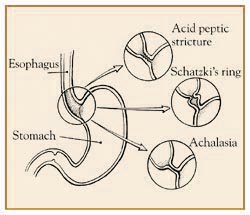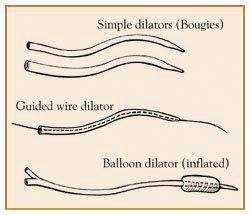What is Esophageal Dialation?
 The esophagus is the long, narrow food pipe (gullet) that carries food and liquid from the mouth to the stomach. It can become blocked or injured in a variety of ways. Esophageal dilatation is the technique used to stretch or open the blocked portion of the esophagus.
The esophagus is the long, narrow food pipe (gullet) that carries food and liquid from the mouth to the stomach. It can become blocked or injured in a variety of ways. Esophageal dilatation is the technique used to stretch or open the blocked portion of the esophagus.
Causes of Esophageal Blockage
There are several causes of blockage or stricture of the esophagus. They all can make swallowing food and/or fluids difficult. The physician's first job is to find the reason for the stricture or narrowing. The answer can usually be provided by the medical history, physical exam, xrays, and endoscopy (a visual exam of the esophagus using a flexible fiberoptic tube).
- Acid Peptic Stricture - This condition is the most common of all. The stomach produces acid which, in turn, can reflux into the esophagus. This event is frequently worsened by the presence of a hiatus hernia. Over time, the acid and peptic stomach juices injure the esophagus, causing inflammation and then scarring. The fibrous scar then contracts and narrows the esophageal opening.
- Schatzki's Ring - This condition is really exactly that, a narrow ring of benign fibrous tissue constricting the lower esophagus. Physicians still do not know how it develops.
- Ingestion of Caustic Agents - Children are particularly prone to swallowing liquid lye and other agents which can severely burn the esophagus, leaving it narrowed.
- Achalasia - This condition is uncommon and quite fascinating to physicians. The problem is a persistent and marked spasm of the lower esophageal muscle. This spasm just does not open up to allow food and fluid through. The result is a persistent blockage with subsequent slow trickling of the esophageal contents into the stomach.
- Tumors - Various forms of tumors, benign and malignant, can block the esophagus. This condition is obviously very important to diagnose and treat promptly.
- Heredity - The esophagus may be partially or completely blocked at birth.
- Eosinophilic Esophagitis - This is a relatively common narowing of the esophagus usually seen in young individuals.
Methods of Esophageal Dilatation
In most instances, the problem is a mechanical one with an obstruction acting like a dam across a stream. Therefore, the treatment must be mechanical. The dam must be broken. After a diagnosis is made, the physician determines the method of treatment that is in the patient's best interest. The physician has a variety of techniques available. Each has benefits and is appropriate in specific cases. The physician will always discuss these options with the patient.
- Simple Dilators (Bougies) - These are a series of flexible dilators of increasing thickness. One or more of these are passed down through the esophagus at a setting. The bougie is the simplest and quickest method of opening the esophagus.
- Guided Wire Bougie - In some instances, the physician performs endoscopy and places a flexible wire across the stricture. The scope is removed and the wire left in place. A dilator with a hole through it from end to end is guided down the esophagus and across the stricture. One or more of these dilators are passed over the wire. At the end of the exam, the wire is removed. This type of treatment may be performed in the x-ray department under fluoroscopy.
- Balloon Dilators - Flexible endoscopy allows the physician to directly view the stricture. Deflated balloons are placed through the scope and across the stricture. When inflated, they become sausage shaped, stretch, and break the stricture.
- Achalasia Dilators - Achalasia is a special situation which requires a larger, balloon-type dilator. The procedure is always done under x-ray control. In this situation, the spastic muscle fibers in the lower esophagus are stretched and broken, which in turn allows easier passage of food and liquid into the stomach.
The Procedure

As mentioned, there are a number, of dilating techniques available to the physician. If endoscopy isperformed at the same time, then it will be done in the endoscopy suite, usually under sedation. X-ray fluoroscopy equipment may be needed, so the procedure is also performed in the x-ray unit. Simple bougie dilatation may take only a few minutes. The other techniques require 20 to 30 minutes. Recovery is usually quick and the patient can soon begin eating and drinking to test the effectiveness of the treatment.
Complications
Esophageal dilatation is usually performed effectively and without problems. However, some complications can occur. A small amount of bleeding almost always happens at the treatment site. At times, it can be excessive, requiring evaluation and treatment. An uncommon but known complication is perforation of the esophagus. The wall of the esophagus is thin and, despite the best efforts of the physician, can tear. An operation may be required to correct this problem.
Alternative Treatments
The alternative treatment options are to do nothing or to undergo major chest surgery. The latter is recommended only if dilatation is ineffective.
In Summary
Narrowing or stricture of the esophagus is a very common problem. The physician can almost always uncover the specific cause of the stricture. There are a variety of treatment options available for the physician. Complications are rare and, in most instances, a satisfactory outcome occurs with complete clearing of or improvement in the swallowing problem.